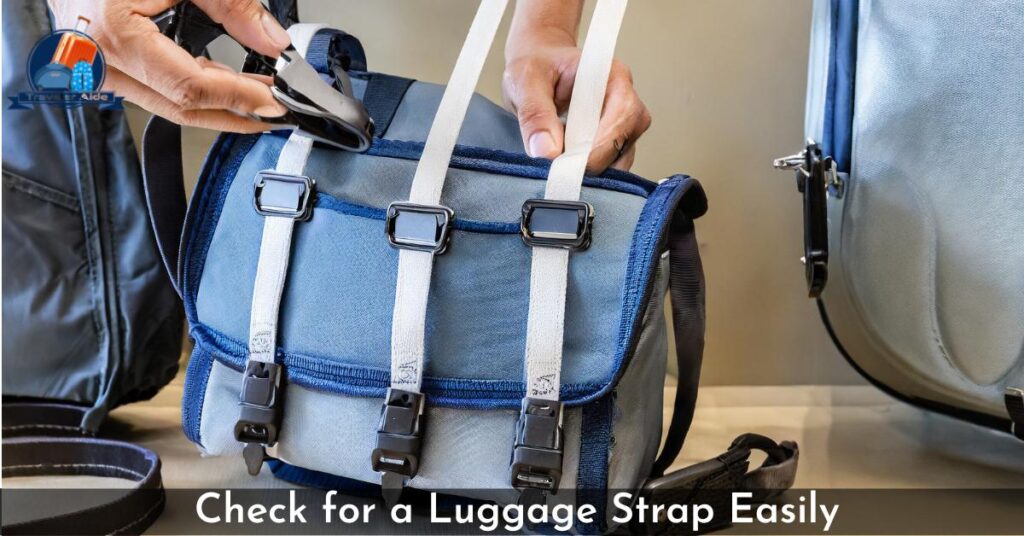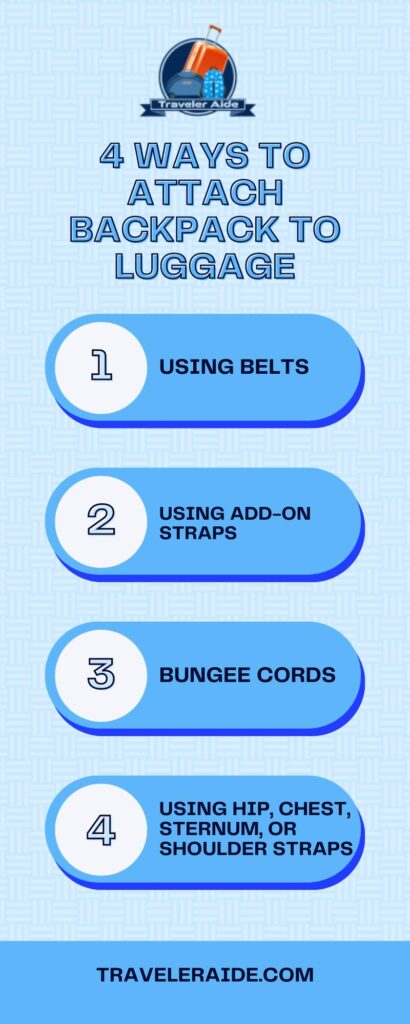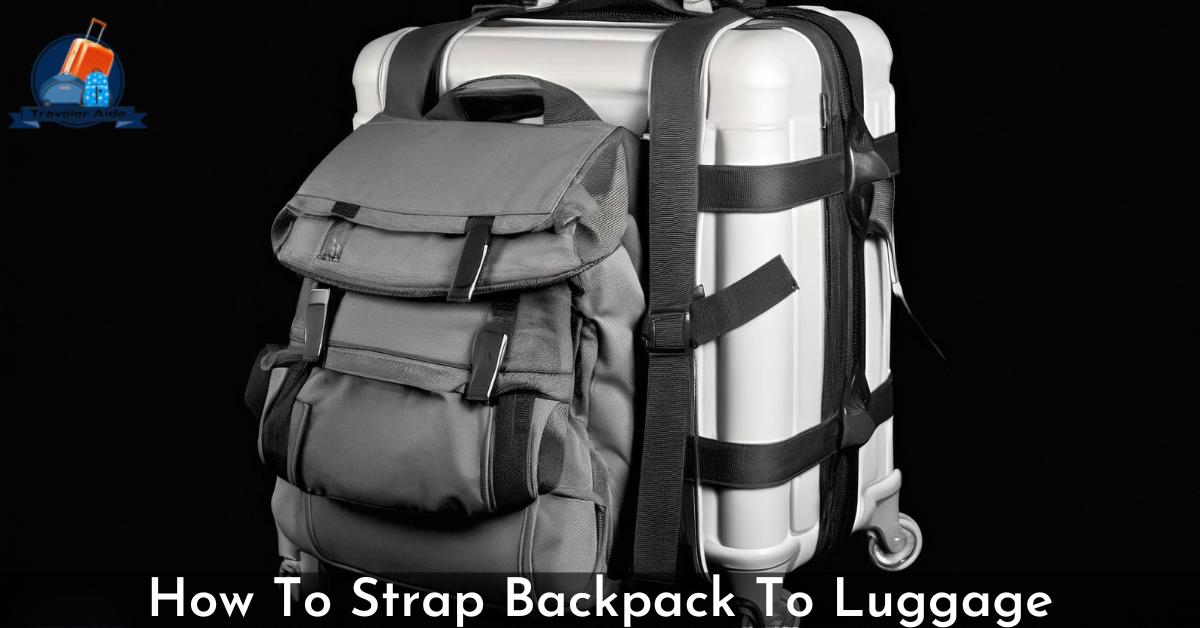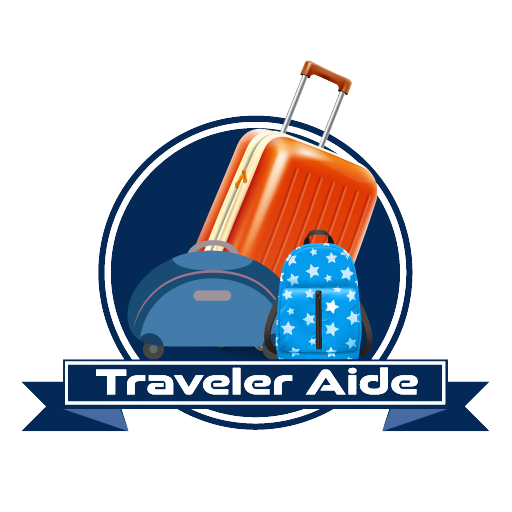I am able to testify from personal experience to how difficult it may be to carry a backpack and a luggage separately. It complicates navigation in areas such as airports. However, there are several methods to strap backpack to luggage.
This study will demonstrate for you—how? According to some research, traditional backpack straps are flexible. Backpacks are flexible enough to move freely on a human back. I’ll go over many techniques, such as bungee cords, handles, and specialty straps. I’ll go over the benefits and problems to watch out for with each technique. You may then decide which option best suits your needs.
You’ll be able to move about more effortlessly and free up your hands once you get the hang of it. Let’s follow our instructions and look at these methods to fasten your backpack to your suitcase so that your journey goes much more smoothly.
DIY Backpack-Luggage Attachment
How to Make a Backpack-Luggage Attachment? Here’s an easy and effective way to connect your backpack to your bags that you can make yourself using items that are easy to find:
What Materials needed:
- 2 strong fabric straps (12 inches long and about 1 inch wide)
- Two metal D-rings
- Pair of scissors
- Lighter or heat sealer (not required)
How to Do It:
- Cut the straps out of the nylon: Cut each strap to the length you want. You can change the length if you need to.
- Put the D-rings: By putting one end of each nylon strap through a D-ring. To make a loop, fold the strap back and sew it firmly to itself. To keep the ends of the netting from breaking, you can fix them with a lighter or a heat sealer.
- Connect the straps to the backpack: find the chest strap or any other attachment points on the back of the backpack. Use carabineers or loops of rope to connect one D-ring to each connection point.
- Put the straps around the bags: The D-rings on the backpack straps make holes that the bag handle can fit through. Make sure the straps are tight enough to hold the backpack on the suitcase handle.
Tips:
- You can use two sets of straps, one at the top and one at the bottom of the backpack, to make it safer.
- If you don’t have leather bands, you can use strong fabric strips, like cloth or denim.
- You can use big metal screws or even strong buttons instead of D-rings if you don’t have any.
Concerns About Safety:
- When you use scissors and needles, you should always be careful.
- Before you use the device, make sure it is safe.
- Do not send too much to the file.
If you follow the above mentioned advice, you can pass over your common issues.
Choosing the Right Luggage for Backpack Attachment
Selecting the appropriate gear for attaching to a backpack can help you enjoy your trips more comfortably and easily.
Here are some things to think Strap Backpack To Luggage:
Size of luggage
Check to see if the bag has enough room for your backpack. You should be able to slide the luggage handle through the backpack’s luggage pocket without any trouble.
Style of luggage
Rolling luggage and tote bags are the two main types of luggage that work well with backpacks. It’s easier to move rolling luggage around, while duffle bags are usually lighter and smaller.
Features of luggage
Find bags that come with a travel sleeve and compression straps and pockets to help you keep your things in order.
Material for luggage
Make sure the materials used to make your bags are strong so it can handle the use of travel. Think about polycarbonate, nylon, or bulletproof polyester as possible materials.
Weight of luggage
Pick luggage that isn’t too heavy and is easy to move around. This will help you carry your backpack and bags at the same time.
You can start cutting down your options once you’ve thought about these things. For specific suggestions on gear that works well with backpacks, here are some ideas:
S’Cure Spinner by Samsonite
This rolling luggage comes with a luggage bag and compression straps and pockets to help you keep your things in order. Made of long-lasting plastic, it’s very light at 7.8 pounds.
Travel Pro Maxlite 5 Expandable Carry-On Rollaboard
This rolling luggage comes with a luggage bag and compression straps and pockets to help you keep your things in order. The fabric used to make it is strong, and it only weighs 6.6 pounds.
Transporter Duffle from Osprey
This tote bag has compression straps, a luggage sleeve, and pockets to help you keep your things in order. The bulletproof fabric used to make it is strong, and it only weighs 3.5 pounds.
Make sure that the bag you pick is easy to carry and will meet your needs for your next trip.
Check for a Luggage Strap Easily

Many suitcases come with a built-in luggage strap that you can use to attach your backpack. It’s always a good idea to check your luggage to see if it has one. A luggage strap can save you time and effort. As you don’t need any other things to attach your backpack for hiking.
- Adjust the strap to fit your luggage size.
- Place your backpack on top of the luggage, also try to optimize the luggage and backpack for ease enhance travel.
- Secure the luggage strap around both the luggage and the backpack.
- Tighten the strap to ensure that your backpack is securely attached to your luggage.
Benefits of using a luggage strap
- Saves you time and effort.
- You don’t need any extra equipment for keeping luggage on roof rack .
- Keeps your backpack attached to your luggage in secure way.
Why Do You Need to attach your backpack to your luggage
You may need to connect your bag to your luggage for a number of reasons. Many people do it for the following reasons:
To help you carry your bags more easily:
Putting your backpack on top of your bag can help spread the weight and make it easier to carry if you have a lot of stuff to carry.
To get your hands free:
Putting your backpack on top of your bags can free up your hands so you can do other things when you have a lot the carry.
Make sure no one steals your bag by:
Putting your backpack on top of your luggage can help keep it safe if you are traveling in a busy area.
To make sure you don’t lose your backpack:
If you often forget things, tying your bag to your luggage can help you find it again.
Along with these benefits, connecting your backpack to your bags may also make your trip more comfy. When you connect your bag to your luggage, you don’t have to carry it on your back. This can help keep your back healthy and keep you from getting tired.
Here are some ways to hook your backpack up to your bags:
Use a strap for your bag:
A lot of bags come with a case that fits over the handle of your trunk. This is an easy and quick way to connect your backpack to your bags.
Strap your bags down:
You can use a luggage strap if your bag doesn’t have a luggage pocket or if your suitcase has a very thick handle. If your bag doesn’t have a luggage pocket, you can use a luggage strap instead. People usually make them out of fabric or cotton, and they close with a buckle. To keep your backpack in place, you can loop the luggage strap around both your backpack and the bag handle. Then, tighten the buckle.
Make sure that the connection is safe:
Make sure the connection is safe before you leave for your trip. When you’re in a busy place, you don’t want your backpack to fall off your bag.
NB: If you follow these tips, it will be easy to connect your backpack to your bags, which will make your trip more comfy and easy.
How To Attach Backpack To Luggage: 4 ways
Backpacks and luggage are two must-have items for travelers. But having both can be hard and tiring, especially in busy places like train stops or airports. There are a few different ways to connect your bag to your luggage, which makes it easier to move both of them at the same time. You can connect your bag to your suitcase in four different ways:

- Method 1: Using Belts
- Method 2: Using Add-on Straps
- Method 3: Bungee Cords
- Method 4: Using Hip, Chest, Sternum, or Shoulder Straps
Method No. 1: Use a Belt
Using a belt is another simple and effective way. Especially to attach your backpack to your luggage. You can use any belt that’s long enough to wrap around your luggage and backpack. Thread the belt through the backpack’s handle. Or shoulder straps and wrap it around the luggage. Buckle the belt in proper way to secure the backpack in place.
Advantages of using a belt include the availability of a belt. Thus making it an easy and affordable solution. But, using a belt can also cause scratches and damage to your luggage. So it’s important to wrap the belt tightly and securely to avoid any damage.
Legg, S. J., (2004) study titled “Effect of single and double strap backpacks on lung function” stated that there is a shift in lung function characteristic of a restrictive ventilatory impairment when military personnel carry moderate to large weights in backpacks or when body armor pressures the chest. The impact on lung function of a lesser burden, such the 6 kg that students usually carry in their backpacks, is unknown. No research has looked at the impact of various strapping techniques on lung function when it comes to backpacks.
I have discussed importance of Handbags in Everyday Fashion in another post.
Belts are one of the easiest and most convenient ways to connect your bag to your suitcase. No matter what shape or size your bags are, a strong belt can securely attach your backpack to them.
- Get the things you need together: You’ll need a belt that’s long enough to go around your backpack and your other bags. The best thing to use is a suitcase strap or a nylon belt.
- Place your bags in this way: Lay your bags out on a flat surface and raise the handle to a comfortable level.
- Secure the backpack: Wrap the belt around the waist strap or compression straps of the backpack to make sure it fits well.
- Add these to the luggage: Make sure the belt goes through the backpack’s connection point as you loop it around the bag handle.
- Tighten and secure: Fasten the belt clip and pull it tight until the backpack is securely linked to the bag.
Method No.2: Using Add-On Straps
If your luggage doesn’t have a built-in luggage strap, you can always buy an add-on strap. Add-on straps are available in travel stores and online. They are a great alternative to luggage straps and can be used with any luggage.
How to use an add-on strap to attach your backpack
- Attach the add-on strap to your luggage by looping it through the handle or any other secure point.
- Place your backpack on top of your luggage.
- Secure the add-on strap around both the luggage and the backpack.
- Tighten the strap to ensure that your backpack is attached to your luggage in secure way. The backpack is fully okay for air travel.
I have discussed on Convenience and Functionality of Convertible Luggage in another post.
Different types of add-on straps available
Elastic Straps
These straps are adjustable. It can be stretched to fit different sizes of luggage and backpacks.
Buckled Straps
These straps are adjustable. That come with a buckle that you can use to tighten. Or loosen the strap.
Luggage Sleeves
These are bags that you can slide your backpack into. The sleeve then attaches to the handle of your luggage.
Advantages of using an add-on strap
- Can be used with any luggage.
- Widely available in travel stores and online.
- Adjustable and can be used with different sizes of luggage.
I have covered What Size Backpack Does my Child Need in another post.
Adding bands is a specific way to connect bags to luggage. The materials used to make them are usually strong, like cotton or netting, and they have buckles to keep them in place.
- Connect the extra strap: Loop the extra strap through the marked connection points on your bag, which are usually near the top or bottom.
- Stretch the strap: You can change the length of the extra strap so that it fits easily around the suitcase handle.
- Attach to the luggage: Attach the buckle on the extra strap to the luggage handle or any other safe spot on the bag.
- Tighten and secure: Fasten the clip and pull the strap tight until the backpack is securely attached to the bag.
Method No. 3: Bungee Cords
Another way to attach your backpack to your luggage is by using bungee cords. Bungee cords are stretchable cords that come in different lengths and sizes. They are manufactured from an elastic material, usually rubber. And have hooks on both ends that can be attached to your backpack and luggage.
To attach your backpack to your luggage using bungee cords.
First, secure the bungee cord to the top of your backpack. Make sure the hooks are attached to the loops on your backpack.
Next, stretch the cord over your luggage. And hook the other end onto a secure part of your luggage. This could be the handle or any other sturdy part of your luggage.
Benefits of using bungee cords include the flexibility and adjustability of the cord. Thus making it easier to fit different sizes and shapes of luggage. But, it’s essential to be careful when using bungee cords. As they can snap back and cause injury.
N.B: Always keep them away from your face. Also body when stretching and releasing them.
I have discussed on What To Bring To School Instead Of A Backpack: 5 Ideas For Anything but a Backpack Day in another post.
Bungee cords are a flexible and adaptable way to connect your bag to your gear. Because they are stretchy, they absorb movement and keep the backpack from bouncing around too much.
- Make sure the backpack fits well by wrapping one end of the bungee cord around the waist strap or compression bands.
- Add these to the luggage: Tie the bungee cord around the suitcase handle or any other safe spot on the bag.
- Put the bungee cord in a tight knot or use a clip to hold both ends together.
Method No. 4: Using Hip, Chest, Sternum, or Shoulder Straps
Using your backpack’s straps for something else can be an easy and quick way to attach it to your bags.
- Find the straps: Depending on their length and placement, use your backpack’s hip strap, chest strap, neck strap, or shoulder strap.
- Secure to backpack: To attach the strap to the backpack, wrap or loop it around the body of the backpack to make sure it fits securely.
- Attach to the luggage: To connect the strap to the luggage, wrap or loop it around the handle or any other safe part of the luggage.
- Tighten and lock: You can change the length of the strap and secure it with a buckle or closure that looks like a clip.
NB: By using these tips, you should be able to connect your backpack to your bags, which will make your trip easier and more comfortable. Remember to pick a way that works for you, your bag, and the style of your gear.
Handle/Shoulder Straps/Other Straps
Most backpacks come with handles, shoulders, or other straps. You can use that to attach your backpack to your luggage. These straps are designed for carrying your backpack. But can also be used to attach your backpack to your luggage.
How to use the handle, shoulder, or other straps on your backpack to attach it to your luggage:
- Place your backpack on top of your luggage.
- Secure the straps around the handle. Or any other secure point on your luggage.
- Tighten the straps to ensure that your backpack is securely attached to your luggage.
I have discussed Should I Put a Luggage Tag on My Carry-on in another post.
Tips for securing your backpack using these straps
- Make sure the straps are tight and secure.
- Do not overload your backpack. As it can make it difficult to attach to your luggage.
- Always double-check that your backpack is attached to your luggage in secure way.
How Get a Dedicated Carry-On Backpack
If you frequently travel with both a backpack and luggage. Consider investing in a dedicated carry-on backpack. A carry-on backpack is a specially designed backpack. That’s designed to fit securely on top of your luggage. They come with built-in straps and hooks. That can easily attach to your luggage.
Choosing a dedicated carry-on backpack, look for features like a built-in luggage strap. Sturdy and adjustable hooks, and many compartments for easy organization. Some carry-on backpacks even have detachable daypacks. Thus making them a versatile and practical option for travel.
To attach your carry-on backpack to your luggage. First, place your backpack on top of your luggage. Secure the built-in straps or hooks to your luggage. Thus making sure they are tight and secure. This way, you can easily wheel both your backpack and luggage.
I have discussed Tips to Pack a Carry On for Winter Travel, Ergonomics of Backpack Straps in another post.
Expert Travelers’ Review: How To Attach Backpack To Luggage
With backpacks and other bags, it can be hard to find your way by means of airports, train stops, and busy streets. Putting your backpack on top of your bags can make your trip easier to handle. Here is a full guide on how to connect your bag to your suitcase, along with evaluations of the best ways to do it by experienced travelers:
Review 1: Utilizing Luggage Sleeves
Most people agree that suitcase bands are the easiest and most handy way to attach a backpack to luggage. A lot of backpacks have bag bands built in that are made to fit over the handles of your suitcase.
Expert Traveler Review:
“One of my favorite ways to connect my backpack is with luggage bands. They are very simple to use and offer a safe way to connect files. The only bad thing about them is that not all bags have them.” – Sarah L., Travel blogger
Review 2: Employing Add-on Straps
Many expert tourists choose add-on straps because they are flexible and easy to connect. People usually make these straps out of strong materials like nylon or fabric, and they have buckles on the ends to make them fit snugly.
Expert Traveler Review:
“Add-on straps are my favorite way to connect my backpack, especially when I have a lot of stuff to take. They’re strong, can be adjusted, and spread the weight out well.” – David M., Frequent business traveler
Review 3: Harnessing Bungee Cords
Experienced travelers like bungee bands because they are flexible and can absorb movement, which keeps the backpack from bouncing around too much.
Expert Traveler Review:
“You can connect a backpack to another backpack or a backpack to a tote bag with bungee cords. They’re small, light, and easy to pack, and they connect securely without being too stiff.” – Emily J., Adventurous backpacker
Review 4: Repurposing Backpack Straps
Smart tourists often use the straps that come with their backpacks to connect things, which makes this choice easy to find and use.
Expert Traveler Review:
“If you can’t find any other fittings, reusing bag straps is a great last alternative. Make sure the strap you pick is long enough and strong enough to securely hold your backpack.” – John K., Budget traveler
Additional Expert Guides:
- Weight Distribution: Make sure that your bag and luggage are properly distributing your weight so that you can carry them comfortably and without strain.
- Check the attachments: Check the connection method often to make sure it stays secure, especially when going on long trips.
- Use Compression Straps: Tighten the compression straps on your bag and luggage to keep them from moving around and to keep their shape.
- Pick luggage that works together: You should choose bags with a strong handle that can hold the weight of your backpack.
- Place comfort first: Adjust the straps and fittings to make sure the bag fits well and doesn’t put too much stress on your shoulders and back.
N.B: Note that the connection method you choose will depend on the style of your luggage, the shape of your bag, and your own personal tastes. Try a few different approaches until you find the one that works best for you.
Some Helpful Extra Tips
- Before attaching your backpack to your luggage. Ensure that the weight distribution is properly balanced. Also make sure that your luggage is stable. It is helpful for luggage backpack enhancement with strap.
- When using bungee cords, make sure they are not too tight. As this can damage your backpack or luggage.
- If you frequently travel with both a backpack and luggage. Consider investing in a dedicated carry-on backpack. That is designed to attach to your luggage. Also consider Backpack Strap for Phone Pouch.
- If you are unsure about how to attach your backpack to your luggage, ask a travel agent or airport staff for assistance.
FAQs on attaching your backpack to your luggage
How Do You Secure Backpack Straps For Travel?
When traveling, use elastic bands or Velcro straps to keep Secure Backpack Straps neat and short. Some backpacks have special systems that allow you to roll or tuck away the straps. This keeps them neat and prevents them from getting tangled.
How Do You Secure A Bag On Top Of A Suitcase?
You can use special straps or bungee cords made for this purpose. They wrap around the suitcase and the bag on top to hold them securely. This prevents the bag from moving around or falling off the suitcase.
How Do You Strap A Backpack?
Make the backpack comfortable by adjusting the shoulder, chest, and hip straps. Distribute the weight evenly. First, make sure the backpack fits snugly on your back. Then, fasten the chest strap across your chest and the hip straps around your hips if your backpack has them.
What Is A Trolley Sleeve On A Backpack?
A trolley sleeve is a special sleeve or strap on the back of a backpack. It slides over the handle of a rolling suitcase, allowing you to attach the backpack to the suitcase. In places like airports, it’s easier on your body to carry both things at once.
Are Luggage Straps TSA-Approved?
Yes, most luggage straps are TSA-approved. Debrah, H. N. (2021) titled “Exploring Airport Screening Process Improvements Homeland Security Managers Need to Establish Public Trust with TSA” predicted that straps keep your luggage safe, and TSA agents can open them easily. But it’s important to look for the TSA logo or label on the strap to show it follows TSA rules. Always verify TSA compliance to ensure a hassle-free travel experience.
Final Suggestions
In my depth research and review proved that connecting your backpack to your luggage can make travel easier. Whether you’re traveling for fun or work, these tips can help you find the best way to do it.
Check if your luggage has straps or use extra ones to attach your backpack tightly. You might also think about getting a backpack made for travel.
Following the above mentioned steps will let you travel hands-free, giving you more time to enjoy your trip. I hope this research has helped you learn how to attach your backpack to your luggage.
Feel free to make a comment in our remarks box and share our thoughts to your dearest one. Wish for your safe journey!
References
- Legg, S. J., & Cruz, C. O. (2004). Effect of single and double strap backpacks on lung function. Ergonomics, 47(3), 318-323.
- Debrah, H. N. (2021). Exploring Airport Screening Process Improvements Homeland Security Managers Need to Establish Public Trust with TSA (Doctoral dissertation, Colorado Technical University).

Hey, I’m Dorothy E. Turner! I’ve spent years exploring the world and diving deep into the travel scene. Along the way, I’ve developed a real knack for understanding what makes a great travel backpack. I’m passionate about sharing my expertise to help fellow travelers find the perfect backpack for their adventures.



32 thoughts on “How To Strap Backpack To Luggage: Travel Hack 101”